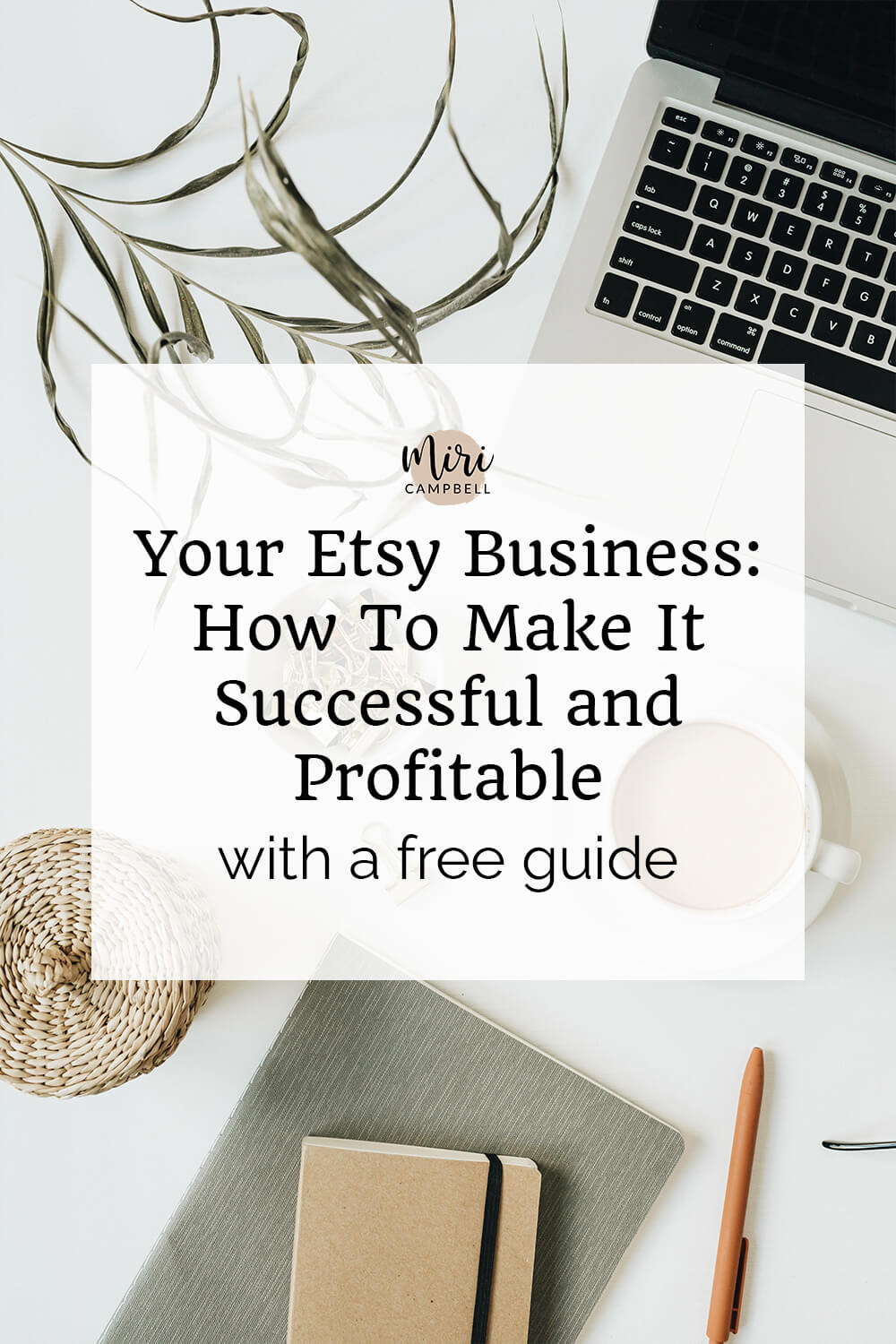
Your Etsy Business: How to Make it Successful and Profitable
My Etsy business story
When I first decided to start my online Etsy business 6 years ago, I had a million questions.
I knew Etsy because I’d shopped there before, and I knew it required minimal start up and investment to get off the ground, so it seemed like a good enough starting point. So, I did all the work to set up and excitedly opened my new digital printables shop.
But nothing happened.
Not even one sale in the first week.
I wanted to give up my Etsy business there and then.
However, prepared to give it another shot, I went into investigative research mode. I wanted to find out everything I could about this Etsy machine so that my shop would be a success. I read blog posts, listened to podcasts, watched videos, took online courses, and developed a strategy for how to run a successful Etsy business.
And it worked.
I used my hard-learned strategy and saw sales and traffic increase.
And my shop became successful.
But do YOU need to spend 6 years working out how to make your Etsy business successful?
No way!
Instead, I have everything you need to know to have a successful and profitable Etsy business.
And it starts at the VERY foundation of what you should do first … so no sweat if you’re a newbie. Simply follow the steps and soon you will have your own profitable Etsy shop.
Here are your steps to running a profitable Etsy business:
Step 1. Believe
Believe that you can create a thriving business selling what you create.
All you need is a desire to make a living doing something you love and you’re well on your way to having everything you need!
When you look at successful Etsy shops, you’ll see that those Etsy sellers who are making the most sales are really passionate about what they do.
They absolutely love what they make and sell. They believe that their products enhance their customers’ lives. These sellers are committed to focusing on the value their product gives their customers.
Step 2. Get inspired by other Etsy business owners
The next step is to get inspired by other online Etsy businesses.
Look on online marketplaces like Amazon and eBay to see what’s popular and what your customers are buying.
Browse through lists like: Hot New Releases, Movers and Shakers, Most Wished For to find products that are popular and trending.
For an idea about what is trending on Etsy go to Erank.com and EtsyHunt.com; online sites which both have data about what is selling.
The top sellers lists on both of these sites, are especially interesting as they let you drill down to the top sellers in your category. You can then visit these top-performing shops to see what products are particularly popular.
On Etsy: Type ‘Trending now‘ into the Etsy search bar to see all the trending products on Etsy. Additionally, try doing a quick search on Etsy for your proposed product and see what comes up. Look at how many results there are. As you do this exercise, don’t feel put off by the amount of competition. Competition is actually good. It shows that there is a market for what you are choosing to sell.
Instead focus on:
- How could you improve on the items that popped up?
- What similar product could you make and how would you make it stand out?
- How could you add additional value so that your audience want to buy the product from you rather than your competitor?
- Could you make your product photos stand out from the competition?
- What could you do differently?
Many Etsy business owners find success by focusing on one, very small, specific niche area and becoming an authority.
For example, if your Etsy shop sells printable art for babys’ nurseries only and you live and breathe this topic through social media, you will create lots of interest.
Step 3. Branding
Many people view brand as the logos and look of a business but it’s so much more than that. Your brand is the vision and the mission of your business. It’s the heart and soul of your business. Your brand is your recognizable personality.
It’s about how you want customers to feel when they interact with you and your business.
But, that said, don’t spend a long time choosing colours or agonizing over a logo.
These aspects are tiny parts of your brand. Instead, think about how you connect with your customers to give them an incredible experience. However, do make sure your brand design elements are consistent across your business.
So, choose 5 colours for your palette and 2 fonts and use these across your shop; in your logo and in your product photos. You can quickly design a logo and make an Etsy banner for your shop in Canva.
Step 4. Stock your shop
If you don’t already have your products, now is the time to get creating.
Yay!
It is a fact that the more items you have in your shop, the more successful you’ll be.
Increasing the number of items increases the chance that a customer will find you. Having more products gets you seen. So, aim for about 50 items to start with but plan in building on this number as your shop grows.
If you’re getting hot and bothered at the thought of producing that much inventory, then it’s fine; calm yourself because I’m here for you. I have lots of ways to add new products without spending hours on development.
Read my blog post here to get the lowdown.
Step 5. Awesome product photos
Product photos are one of the most important ways to drive traffic and sales to your shop.
They need to grab your customer’s attention and compel them to click through to your shop.
Then your photos need to answer all of your customer’s questions about your product.
And at the same time, they need to look clear, clutter-free and beautiful.
Luckily, when selling printable products, you don’t actually need to pick up a camera.
Instead, you can feature your items in mock-ups and stock photos.
Creating a mock-up image is easy and I walk you through how to do it in this blog post.
Step 6. Write compelling descriptions
Your product description is the complement to your product photos.
Here you can have a conversation with your customer as if you were meeting face-to-face.
Be friendly and try to answer any questions your customer might have.
Consider what information they would be gathering if it was a bricks-and-mortar store and include that in your written description.
If you can engage your customers with a story, they’ll forget they’re buying.
So, tell a story about your product such as how you developed it, how you were inspired, or obstacles you overcame to make it. Whatever story you choose to tell, fascinate your audience so that they can’t wait to buy your item.
Read How to Write an Etsy Product Description for further help with this.
Step 7. Price your products perfectly
Mmm. Pricing your products can be tricky.
You don’t want to price too high because people won’t buy but if you price too low, you won’t be able to make a living.
So, you need to think about the time it’s taken to create your product and any costs that you paid to create it.
You can also do some research to see what other sellers are charging for similar products in your niche.
Be wary, however, of pricing your products below what your competitors are charging.
Competing on price is not always the best strategy.
Low price items can give the impression of being low quality.
My pricing strategy is guaranteed to work every time and you are welcome to take a look and use it yourself to price your products.
Step 8. Do keyword research
Keyword research requires you to think like your buyer.
If you were shopping for your item, what would you type into the Etsy search bar?
It’s important that you use a strategy when it comes to choosing keywords, rather than choosing them randomly.
You need to have evidence and know that the keywords you’re using will be effective.
I have a blog series dedicated to Etsy SEO here with links to many tools and techniques to help you identify the right keywords to use.
Step 9. Follow the Etsy business rules
Etsy is an ideal platform to start your shop from scratch as they offer everything you need to set up your shop and get selling.
However, there are some rules that sellers need to follow.
Read through these guidelines before launching your shop so you can have the best possible experience on Etsy.
Step 10. Promote, promote, promote
Once your shop is up and running you need to tell people about it.
The number one way to do this is to use Pinterest.
You can link your shop to your Pinterest account and pin images of your products directly from your Etsy page.
Also, you can also use Facebook and Instagram to get the word out about your shop.
Additionally, you may want to think about starting a blog. Not only is this a great way to market yourself, by building up your brand and sharing value with your audience, but it becomes an asset for you.
Now you’re ready to grow your own Etsy business
So, let’s do this…
If you have been thinking about opening your own shop and just needed a little persuasion to get started, then you’re all set and now is the perfect time.
I hope this post has helped you and that you’re feeling inspired to start a business and live a life you love.
Remember I’m here to help you, so you’re in good hands and well on your way to making an online income. I can’t wait to see the business you build.
Let me know in the comments below which parts of the Etsy Shop Guide were the best help for you.

